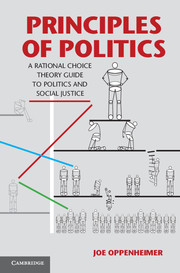Book contents
- Frontmatter
- Contents
- Propositions and Corollaries
- Tables
- Figures
- Sidebars
- Definitions
- Preface
- Overview of the Book
- Acknowledgments
- Introduction: Politics, Universals, Knowledge Claims, and Methods
- Part I The Logic of Collective Action
- Part II Collective Choice
- Chapter 4 Individual to Collective Choice in One-Dimensional Politics
- Chapter 5 Individual to Collective Choice More Generally
- Part III Political Institutions and Quality Outcomes
- Part IV Social Justice, Choice, and Welfare
- Bibliography
- Name Index
- Subject Index
Chapter 5 - Individual to Collective Choice More Generally
Published online by Cambridge University Press: 05 August 2012
- Frontmatter
- Contents
- Propositions and Corollaries
- Tables
- Figures
- Sidebars
- Definitions
- Preface
- Overview of the Book
- Acknowledgments
- Introduction: Politics, Universals, Knowledge Claims, and Methods
- Part I The Logic of Collective Action
- Part II Collective Choice
- Chapter 4 Individual to Collective Choice in One-Dimensional Politics
- Chapter 5 Individual to Collective Choice More Generally
- Part III Political Institutions and Quality Outcomes
- Part IV Social Justice, Choice, and Welfare
- Bibliography
- Name Index
- Subject Index
Summary
What we passed off as one-dimensional politics needs further elaboration. After all, when there are numerous issues, or even one issue that is very complex, there may not be such a simple metric as a single dimension upon which all, or even most, people can express their preferences in a single-peaked fashion. So the more general case is certainly politics in more than one dimension. In this chapter we shall examine what happens to group choice when there is more than one dimension along which proposals are located. Begin by examining a simple extension of the analysis of majority rule beyond a single dimension. The extension creates problems we have not encountered yet. Very difficult normative questions are raised and the research regarding these issues is extraordinarily rich. It will be further discussed in Part IV. To begin, I use a simple example to demonstrate many of the problems, much as I did with the hydrant story on U Street. I will then move on to discuss non spatial ways of analyzing the outcomes of democratic political struggles in political situations to see what generalizations can be found. This will lead us, in Chapter 8, to discuss the limitations of translating individual preferences to social choice: the Arrow theorem.
Here’s the simple example. Decisions are made again with a simple majority rule institution with a binary choice rule: Anyone can make a proposal; it has to go against the status quo. If it wins, it becomes the status quo. Beaten proposals are not reintroduced. This time, the group is to decide where to place emergency fire equipment. The possibilities are not points on a road. Placement is anywhere on a two dimensional surface. Add preferences and what can we say about the outcome now?
- Type
- Chapter
- Information
- Principles of PoliticsA Rational Choice Theory Guide to Politics and Social Justice, pp. 116 - 138Publisher: Cambridge University PressPrint publication year: 2012



